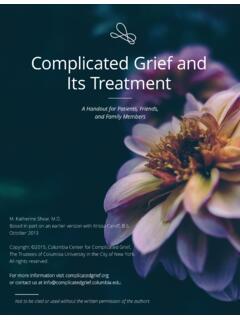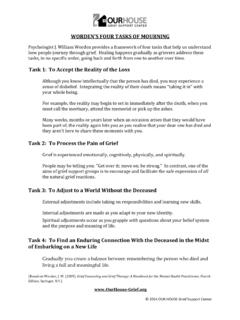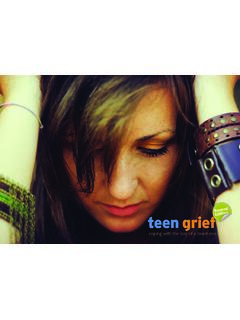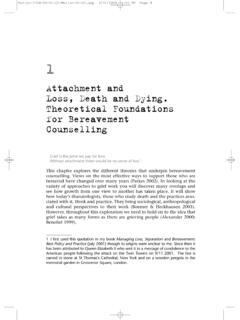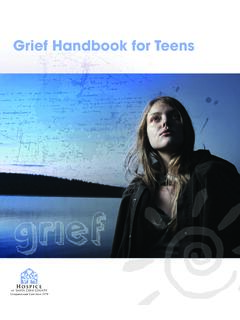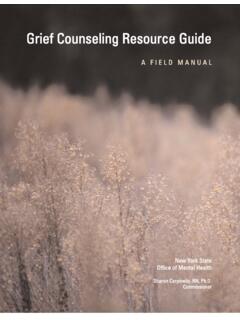Transcription of Complicated Grief Treatment
1 Shear, 2015, Columbia Center for Complicated Grief , The Trusteesof Columbia University in the City of New York. All rights This manual was used in the following NIMH-funded R01 studies: MH60783,MH70741, MH085297, MH085308 and MH0852882 This version is lightly edited for use by practicing clinicians. The editingincludes a preface with useful information for to be cited or used without the written permission of the authorsInstruction Manual Used inNIMH Grants1,2 Complicated GriefTreatment By following the instructions in this manual and using other training supports as needed, you can learn to administer a simple, highly effective Treatment that can change the lives of people caught in a seemingly endless cycle of Grief . -M. Katherine Shear, WITH US: @CompGriefCONNECT WITH US: @CompGriefDISCLAIMERThe information provided in this Manual is for educational and informational purposes only.
2 The Manual is intended for use by experienced mental health professionals, and in conjunction with training and supervision by experts. Columbia University and the Columbia University School of Social Work make no warranties, express or implied, as to the value, usefulness or completeness of any information that is made available in this Using this Manual Summary of Efficacy Study Results Identifying People With CG Co-Occurring Conditions andSuicidality Measurement-Based Care Common Challenges in LearningCGT Overview of the Thinking Behind theTreatment Some selected referencesPhase I: Getting Started(Sessions 1-3)Overview, Phase I Tools and Their Use, Session Instructions Session 1: History Taking Session 2: Information about CGand CGT Session 3: Including a Close Friendor Family MemberPhase II.
3 Core Revisiting Sequence (Sessions 4-9)Overview, Phase II Tools and Their Use, Session Instructions Session 4: First Imaginal Revisiting Session 5: Adding Situational Revisiting Session 6: Adding Memories Forms Session 7: Full core revisiting (1) Session 8: Full core revisiting (2) Session 9: Full core revisiting (3)Phase III Midcourse Review(Sessions 10) Topics for Consideration duringmidcourse review Session 10 instructionsPhase IV Closing Sequence(Sessions 11-16) Overview, Session Instructions Sessions 11 15: Closing SequencePersonalized Sessions Session 16: Ending CGT References AppendixTable of ContentsPrefacePages 5-15 CGT Manual 2015 Pg 6 PrefaceUsing this ManualThis manual provides instructions for a 16-session intervention for Complicated Grief (CG).
4 CG is a painful and impairing condition that affects tens of millions of people worldwide. People with CG have lost someone close and are caught up in relentless pain that dominates their lives and holds hostage their future. Complicated Grief Treatment (CGT) is a well-specified evidence-based approach that can help these people. This Treatment has been evaluated in 3 separate clinical trials with a total of 641 participants. These studies, funded by the National Institute of Mental Health, were uniformly positive with an average response rate of 70%. CGT is the best documented Treatment for CG in the world. By following the instructions in this manual and using other training supports as needed, you can learn to administer a simple, highly effective Treatment that can change the lives of people caught in a seemingly endless cycle of Grief .
5 Working with bereaved people can seem sad and hopeless so clinicians sometimes shy away from it and fear burnout. It may seem paradoxical, but therapists have often told us that learning CGT has been the most rewarding experience of their career. Knowing how to administer a short-term Treatment that has a 70% response rate is very gratifying and a powerful antidote to burnout. A component of learning CGT entails being mindful of your own reactions to death and loss and developing ways to use your responses most effectively. Most therapists find this one of the rewarding aspects of working with bereaved people. People sometimes imagine bereavement as the beginning of a journey but Grief is not a voyage from which people return.
6 We do not experience a period of Grief , come back, and return to life as usual. Instead, Grief is a new homeland. It is a permanent place in which bereaved people must reside and redefine their lives. Life is permanently changed by an important loss. Still, it is possible to restore the sense that life can be rich and satisfying even though Grief is not over. To restore enthusiasm for life is a natural goal of bereaved people. Yet the ways we transform our lives after death of a loved one are as individual and personal as the love that was lost. Bereaved CGT Manual 2015 Pg 7people differ in the kinds of problems they face, and in the adjustments they must make after a loss. People also differ in the availability of supportive companionship and the effectiveness of personal coping mechanisms.
7 People with CG have usually exhausted their supply of both and feel they have nowhere to turn. As a result their Grief does not mature and it remains intense and disruptive. Grief complications prevent people with CG from finding a place of integration where loss and renewal coexist. A CGT therapist can help. This Treatment guides people through a process by which they can restore their capacity for joy and satisfaction in life while accepting the finality and consequences of their loss and maintaining a sense of connection to the person who of Efficacy Study ResultsCGT has been tested in three NIMH-funded randomized controlled trials entailing six separate grants. The first was a randomized controlled trial conducted at the University of Pittsburgh comparing CGT to interpersonal psychotherapy (IPT), a well-tested and very effective Treatment for depression.
8 Results published in 2005 showed CGT was significantly better at alleviating CG symptoms and reducing their impact. The second study also compared CGT to IPT, this time in older adults. This study was conducted at Columbia University in New York City. Results published in 2014 mirrored those in our 2005 study with a lower drop out rate and a higher response rate to CGT but not IPT. The third study was a four-site trial conducted in Boston, New York, Pittsburgh, and San Diego. We compared antidepressant medication to a pill placebo. All patients received either citalopram or placebo. Half of the participants were also randomly assigned to receive CGT. Results again strongly supported the efficacy of CGT. The paper reporting these results has been submitted for therapists were experienced mental health clinicians, including psychiatrists, psychologists, social workers, marriage and family counselors or Grief counselors.
9 They were trained to deliver CGT using the instructions provided in this manual along with ongoing supervision. Therapists PrefaceCGT Manual 2015 Pg 8attended a didactic workshop and then treated at least two training cases. Often a third case was required to reach competence. Each session was audiotaped reviewed separately by the therapist and supervisor and then discussed. Weekly group supervision meetings were held to review cases throughout the study and Treatment sessions were audiotaped for adherence assessments. CGT is not difficult to learn. The Treatment is simple and well-specified. However, many therapists have questions when they are learning a new approach and it is often useful to have an opportunity to discuss difficult cases.
10 We offer a range of different ways to supplement the information in this manual. If you want consultation or supervision or if you have any questions you can contact us at the Center for Complicated Grief People With CGIdentification of CG is not difficult or Complicated . However, the lack of official consensus criteria can be confusing. We provide a simple way to screen and diagnose CG that is very similar to the one we used in our Treatment studies. You can also contact the staff at the Center for Complicated Grief if you have questions about assessment of CG. The way we identified people with Complicated Grief in our studies was as follows:1. A score of 30 or greater on the 19-item Inventory of Complicated Grief (ICG Prigersonet al 1995)2.
